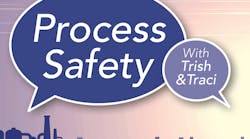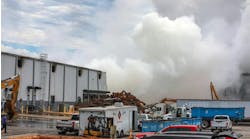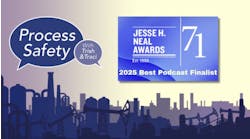Transcript
Traci: Welcome to Process Safety with Trish and Traci, the podcast that aims to share insights from past incidents to help avoid future events. I'm Traci Purdum, editor-in-chief of Chemical Processing, and as always, I'm joined by Trish Kerin, the director of the IChemE Safety Centre and winner of the Women in Safety Leader of the Year Award. Congratulations, Trish.
Trish: Thanks, Traci. I was quite excited to get that notification that I'd won that award, so it's the first time that Women in Safety have actually made the award, so that makes it even a little bit more special that I was selected as the first Leader of the Year, so very proud of that and certainly couldn't have done it without the input and teamwork from my team within IChemE and the Safety Center, but also our members and yourself and all the other people that I interact with as well on a regular basis.
Traci: Well, the award is well deserved and no surprise, and it wouldn't surprise me if they named the award after you in years to come.
Trish: Oh, I don't think so, Traci. But also, congratulations to you for being appointed editor-in-chief of Chemical Processing.
Traci: Well, thank you. Yeah.
Trish: Wonderful. And look forward to continuing to work with you. Obviously, I worked very closely with Mark over the years and he will be missed, but looking forward to working with you.
Traci: Well, thank you. Yes, Mark has been offering me guidance and pointers and hopefully I will be able to fill his shoes. And you and I are now a power team, right?
Trish: Absolutely. Weren't we always?
Traci: Well, I guess. Now it's official. We have the titles now.
Trish: True.
Traci: In this episode, we're going to be talking about safety training. And I shared an article with you a while back on an oil refinery that put on a competition based on safety training tactics, things like removing and installing the valve of the flange, coupling of a gas pipeline in a gas polluted area or providing first aid to an injured person. What are your thoughts on this take on safety training, making it a game?
Trish: Oh, I have so many thoughts. Where do I start? Okay, so some of those thoughts are positive and some of them are perhaps not so positive. What I love about the idea of making something a game is that it engages multiple parts of us as a human, it engages our emotions, as well as what we see, what we hear, what we touch. So, there's actually some positives to gamification of what we do. It allows us to create the psychological anchor so that we remember something when we see a similar pattern come up in the future. So from that perspective, gamification, I think, is a positive thing.
What was a little bit concerning about the article was issues around the fact that they almost made it a race to see who could achieve the outcome the fastest. That worries me because often, when we go at something really fast and we make haste, that's when we make errors that we could have avoided had we taken a moment. I'm not talking about taking hours and hours to make a decision, I'm talking about taking a moment to think about the hazard, to think about the risk and to think about what we're going to do about it in that instance before we actually jump straight in.
So, one of the things that I learned many years ago is fast is slow and slow is fast, particularly when you're working with humans. So if you want something done fast, you actually need to slow down the thinking and think about it and work with the people involved to get the outcome, even in an emergency activity. There are parts of it that worried me from that speed perspective.
Another factor that actually concerned me was that the way this organization had done it, I thought potentially had the risk of creating a hero complex with people. And the reason that worries me is when we get people in a hero complex, they're 10-foot tall and bulletproof and they can do anything. And when they succeed and they achieve what everybody thought was impossible, they're lauded as absolute heroes. But what if they didn't succeed? What message does that send to other people that may not necessarily have the same level of competence? For example, when they see someone rewarded for doing something that is blatantly dangerous, but they got the outcome they were looking for, it encourages other people to do blatantly dangerous things and they may not get the same outcome.
So the hero walking in through the gas cloud without the right protection and without really thinking about it to do something, yet they might be able to stop the leak and that would be great. Or they might blow themselves in the entire facility up in the process. And so, we need to be very careful about the messages we send to people when we do things.
So whilst I think gamification is good from a psychological perspective and there's many advantages to it, we still need to understand the seriousness of what we're involved in here. And I'm a big advocate for having fun in the workplace. It's one of the things that I very much focus on in everything I do. We need to have fun because fun creates positive emotions, which creates these psychological anchors for us. But there are times when we need to be serious, and fun does not mean pranking other people in a dangerous way. Fun means being able to have a laugh with someone.
Yeah, I had many thoughts on this article. As you can tell, they're of a little bit all over the place. Some great, love gamification in the right way. And some really worried me. The fact that we had people competing against each other so they'd set up teams to compete. Well, the moment you start getting people to compete, you actually remove the teamwork objective from the entire organization. So we have the teamwork within the teams, but those two teams don't work together. They're actually working against each other. And so, that can start to set up some interesting cultural dynamics as well. So there's certainly a lot to unpack there.
Traci: I had never really considered every single point that you made, and they are such cerebral, thoughtful points that make absolute sense. And when you said fast is slow and slow is fast, running through it so quickly and you don't grasp it, so you're slow to learn the lessons. So I think great points and just a lot of things I didn't think about. One of the things I did want to talk about and think a little bit more on is should we simulate hazardous conditions in training programs? This gamification that they did, they've tried to simulate some hazardous conditions. Is that prudent?
Trish: I think in some ways, yes. And again, this is not a clear cut question. We should not create hazardous conditions in training programs, but if we have an ability to simulate them effectively, so for example, I've been involved in the past where when we wanted to try and show at least some semblance of a vapor cloud, then either dry ice or a smoke machine was used to at least get people visually seeing that there would be something they'd need to worry about or rigging up a water hose to be slowly dripping to simulate a leak of some sort of product. Those sorts of conditions to be simulating make the training a little bit more real and a little bit more effective. So I like that sort of stuff.
If you're actually using significant hazardous substances to create hazardous environments for training purposes, no, I don't like that idea. That is just waiting for something to go wrong. You often hear the joke about never ask a person to show you what they did when they hurt themselves because chances are, they'll hurt themselves again if they do it again. Or don't ask their friend to show you what they did because their friend will get hurt. And this happens again and again and again. So, ask people to talk to you about something but not to show you necessarily when there's been an adverse reaction because you might just end up generating that same situation again. So I think we need to be careful about how we do it. I think it can be quite a useful way to make the training programs more realistic, which is important.
One of the other things though is that you don't necessarily want to go out and train people, especially if they're not that experienced in adverse really bad conditions, because again, all you're going to end up doing is hurting them. They're going to get injured if we go out and try and do training in a torrential downpour where everything is really slippery. Now the fact is if we had an incident in that situation, that have to respond and that's a different situation. We are forced to respond in that, but we don't want to be forcing people into a situation where they could end up injured because we didn't really think through the training program we were doing. People should never be hurt in a training program as far as I'm concerned. We need to make sure that we can keep them as safe as possible while teaching them the skills they need to be able to respond. And then, continuing to exercise those skills and build up their competence and confidence so that they can respond in a range of different situations.
Traci: Almost like building muscle memory. They're being trained on it in normal conditions over and over that any condition they enter into, it's a muscle memory. Is that a fair assessment?
Trish: Yeah, absolutely. And in fact, that's precisely how I would've described it. That's the reason why we do regular first aid and CPR training if you're a first aider. And I'd recommend anybody should do regular first aid and CPR training because you may not need it at work, chances are you might need it with a family member. But the fact is that we do CPR training on an annual basis so that when it comes to doing CPR on someone, it's complete muscle memory. We don't actually have to think about what we're doing necessarily,, we just shift into it and start that process. We assess the risks. Obviously you always look for danger first before you respond, but if we need to get to that CPR stage, it's muscle memory, we're there.
And we need the same sorts of things with other parts of emergency response in our facilities, whether it's operating a fire extinguisher, other firefighting equipment such as monitors or hoses or whether it is performing first aid in the workplace or whether it is figuring out how we can safely shut down the plant. All those things, once we move into that muscle memory phase, become far more reliable.
Traci: You had mentioned the simulation, the dry ice and simulating. We had an editorial board meeting yesterday and something came up where they were talking about operator training, and one of our board members said that some of these operators don't ever encounter an emergency, and that's wonderful that they don't have that under their belt, but in case of an emergency, they need to know what to do. And they were talking about virtual reality training. Thoughts on that? Is that a great way to train and are there other good ways to train?
Trish: Yes, so I think virtual reality definitely has a place as does augmented reality. So the difference is virtual is a complete immersion within the digital space. Augmented reality is you might be viewing your own facility through the eyes of your iPad or whatever device you're using and actually seeing things pop up on the screen that you are looking at. Like Pokemon Go for example, it's very similar. So those sort of technologies, I think, definitely have a place because they allow us to simulate what can go wrong and start to create that muscle memory.
If we think about the aviation sector, pilots every year have to spend a certain number of hours in a simulator regardless of how many hours they spend actually flying because in the simulator, they practice engine shutting down, they practice emergency landings, they practice all sorts of things going wrong that could be predictable in flight, so that they are trained with their muscle memory in how to respond to it.
The aviation sector has been doing this for decades. We need to catch up in the processing industries and do more of this, more simulation, whether it is through having a unit simulator on your facility, whether it is through augmented reality or virtual reality. If you don't have those technologies available, then actually you can still create some scenarios by giving people different input information of, "This has now happened, what are you going to do now? Okay, now that this is reading a certain amount, what does that mean to you? What are you doing this? You've got this alarm, what's your response?" You can create what we need in many ways depending on how much you're investing in it. The fundamental is we have to get better at this, we have to do more of this.
The technologies are getting cheaper and cheaper to enable us to do these things as well. So for my money, I think we should be moving more towards unit simulators, which are now a lot cheaper than they used to be, as well as virtual reality and augmented reality to help train people in how to shut down the plant or how to deal with the emergency if they've never seen it themselves in real life. And even if they have seen it themselves in real life, they should still be practicing it. Just because a pilot might have had an emergency landing doesn't mean they don't have to do their simulator training that year on emergency landings. That just means they got a little bit extra training that year and that's not a bad thing.
Traci: Now, my brother-in-law is a pilot and if he doesn't do his training, he can't fly. Do you think it would behoove the industry to require this type of training? I don't want to see you can't work, but maybe you lose some sort of privilege?
Trish: Look, that's a really interesting point. I think the issue here is it wouldn't be that you weren't able to work, for example, but it might be that if you haven't done the right amount of training, simulator training for example, then perhaps you shouldn't be working on the panel in the control room unsupervised until you have got your hours up in training scenario. So, you could do the outdoor operator job, which you should have actually worked your way up through outdoor operator before you got to the control room anyway. So you should be competent to be able to do that. And there's some of the sorts of things that I think we could be looking at.
We need to make sure that our facilities have the adequate resources on hand to be able to respond to an incident in a similar way that an offshore platform has to make sure it controls its resourcing, so that it's got the right competencies on the platform at any point in time. We seem to have much more structure around that than we do around onshore facilities from my experience and what I've noticed. So, I think there's definitely improvements to be made in that space. How far we go? Look, I think we're a while off saying, mandated, you need X number of hours, and that may not even be the actual answer we need, but I think we need a way to create the imperative to get people into these areas.
Traci: You cannot anticipate every scenario, but are there basics that carry across all safety emergencies that you can train for?
Trish: Yeah. Absolutely, there are. I mean down to the basic point of mustering or sheltering in place for the majority of the workforce, that's going to happen when the emergency alarm goes out. So everybody should be trained to know what to do in that scenario. That's always going to happen. When you've got an emergency, you're going to hit the emergency alarm. That's first of all going to give you a shelter in place potentially or an alert, and then they give you a muster at that further on, or an evacuation even. So, there are some things like that that are going to appear everywhere. Some of the other really common ones are knowing how to deal with your firefighting equipment because chances are, if you've got a leak, your firefighting equipment is going to be used to suppress a vapor cloud potentially to prevent the ignition. If you've got an ignition, you've got a fire, you're dealing with firefighting equipment.
So again, there's certain aspects of equipment in our facilities that are always going to be the things we need to use on a regular basis. Understanding what your hazards are and understanding what your major incidents could therefore be is a critical part of doing your PHAs anyway. I mean that's why we're doing them. We're doing them to understand what our scenarios are. Once we know what our scenarios are, then we can actually start to plan for them. So plan for how to respond to a leak from the various different units of the various different chemicals or substances you have, and the way that leak may present. Is it going to be a flange? Could it be a corrosion pinhole, Could it be a catastrophic failure? And then have a plan to deal with all of these different aspects depending on the magnitude that you're likely to see.
It's one of the reasons why I really love bow-tie diagrams so much because they show your pathway from the hazard all the way through the top event, which is the potential loss of control incidents, and then your different pathways as to your mitigation controls and what your possible consequences are. Once you've got your bow ties established and you understand the bow ties for all your different units through all your different plants, you'll actually be able to see what your different consequences can be and that's what you build your emergency response on and there's going to be commonalities all the way through those.
Traci: One thing you can't really prepare people for is to be calm. How do you train that? The muscle memory, you can reach a level of zen with that muscle memory, but you still have adrenaline flowing. What can you do in those situations?
Trish: Yeah, that's a really tough one to deal with. And again, some of that comes with experience and some of it comes with other training programs that you can do. So training people on how to respond under pressure. And part of the emergency scenario training, as I said, if you have a realistic situation where you are saying, "Okay, now that's happened, what are you going to do? What are you going to do? What are you going to do?" And you actually really create the pressure that a person is experiencing, that can start to understand what that might be like and that can help them learning to deal with it. And there may be other different personal development or leadership programs that you can put in place to help people learn to deal with managing in an uncertain situation, responding to an emergency from that psychological perspective. So there are things that you can do to help prepare people for that.
Another really critical part of that is the debrief. We actually need to debrief people on what they've been through. When we've put them through something that is so deeply emotionally draining, we actually have to look after them. We have to debrief them. We have to make sure that they are able to release that emotion, and then reflect and learn from it as well. We don't just do the emergency response activity and go, "Okay, everyone did great. Fantastic. We'll see you next year." No, you actually need to talk through these things. And what did we learn? What could we do better? In that situation, you made this decision. Can you talk me through how you got to that decision? Why did you do that at that point in time? Getting people to reflect and think about it is an important thing.
And I think another useful thing can be is in several of the emergency response teams that I have been part of, facility wide coordination and management teams, is everybody has their very specific role that you are trained in. So for example, one of my core roles in one of my roles was the logistics. So it was my job to get whatever resources we needed and that was what I did. That was my focus. I wasn't the person that was logging all the radio traffic and making sure we had a good communication log, and I wasn't the person that was making the technical decisions because it wasn't my area of the plant. If it was my area of the plant, I would've been the technical person. But in another area, I was logistics. What do you need, I'll get it for you.
It can be if you've got the resources to then have a floating person that moves between the different roles and can just actually be a sounding board for that person going, "I'm not quite sure what to do here. I'm a bit stuck. Can you help? What do you think?" Just having someone to talk to can help deal with those high pressure situations. So if you can, being able to have that person that moves between the different groups to try and coordinate it and bring it all together. And likewise, if you're going to have them in the response team in the field, you also need to make sure they're not getting in the way, but an observer, someone observing and noting what's happening and someone that can intervene and say, "Hey, stop a sec. I think we need to do something different." And that can really help to deal with calming the situation a lot more.
Traci: Listening to you talk about that, a point was brought up in my mind. What happens if you have a response team and a couple people are absent that day and there's something that happens? Can you run with a team that isn't fully employed?
Trish: Yeah. Look, that's a really interesting question. Again, if we look at an offshore example, they basically have to have a fully resourced emergency team on site the entire time. And they have to schedule their planning to manage that. And some of the metrics that they use and look at in competency, focus on do we actually have the right competencies on the platform that we need every day, 24 hours a day every day?
When we're talking onshore, again, we probably get a little bit more relaxed about that, and I think we need to be perhaps a little bit more disciplined and make sure that we do have the right competencies available when we need them. And that does mean 24 hours a day. So if it's in the middle of the night, the people you have on site should be capable of dealing with the first initial response. Likewise, during the day, they should be capable of dealing with the first initial response whilst we call in other resources to help.
And what I mean by other resources is predominantly other company people coming in to assist and getting called in on their days off potentially, because we can't always just rely on the emergency services of the city or the county or wherever we are, particularly if we're in a natural hazard triggered event and Natech incident because they're going to be busy dealing with the rest of the community, because it's not only your facility that's having the incident right now, everybody's having the incident right now. So you are going to need to be self-sufficient. You're going to need to make sure you've got the right competencies.
And so, that's where we should be tracking in our lead metrics, that we have the right competencies available at any point in time on our facilities. And if we don't, we need to develop plans to resolve that, so that we do have people available. And if you've got a couple of people off sick, how are you covering their emergency response capability if they're part of that team? You actually need a plan to cover that, not just to cover the person on shift, for example.
Traci: Trish, is there anything you'd like to add that we didn't touch on? We covered a lot of bases here, but is there anything else you want to add?
Trish: I think the key thing for me here is practice, practice and then more practice. What makes great emergency response is continuing to practice what we are doing so that we create that muscle memory, we create that response and that reflex, so we can respond at the right time.
Go back and take a look at the last time your facility did an emergency response activity, and then go and take a look at your scenarios for your facilities, did your emergency response activity reflect your scenarios?
So, often we see instances where sites are really good at doing the first aid response to a worker that's had a cardiac event. And that's great because we still need to know how to deal with that. But when was the last time we did an emergency response on a potential leak or vapor cloud or fire or major loss of containment of some sort? Because they are our major hazard scenarios, and we need to be exercising them. Now's as good a time as any to go back and reflect and review what you've done in the past and plan for 2023. What are you going to do? What scenarios are you going to exercise and how are you going to assure yourself that your teams have the capability to respond in an emergency to the major incident they may face?
Traci: Well, Trish, you're proving once again why you are Safety Leader of the Year with all of this great advice, and I appreciate that. Unfortunate events happen all over the world, and we will be here to discuss and learn from them. Subscribe to this free podcast so you can stay on top of best practices. On behalf of Trish, I'm Traci, and this is Process Safety with Trish and Traci.
Trish: Stay safe.
Want to be the first to know? Subscribe and listen to Process Safety With Trish & Traci on these platforms









